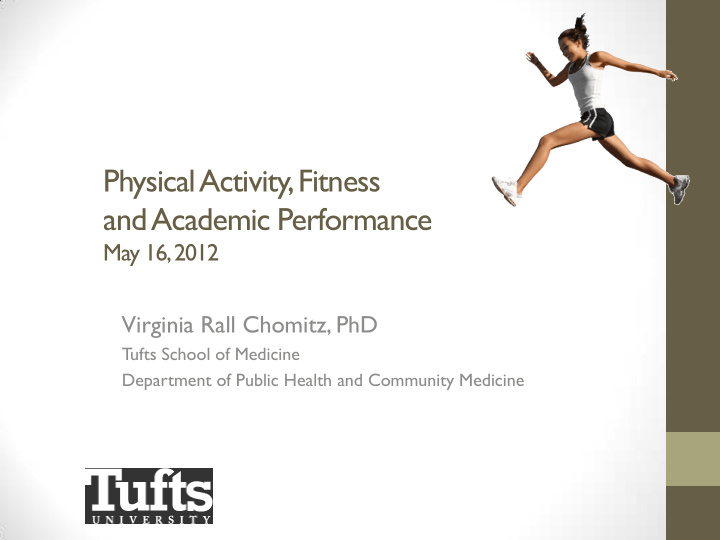



Physical Activity, Fitness and Academic Performance May 16, 2012 Virginia Rall Chomitz, PhD Tufts School of Medicine Department of Public Health and Community Medicine
Today • Definitions & benchmarks • Policy Context • Framework & Evidence • Opportunities for increasing PA during the school day
Setting the stage: Physical Activity: • A ny bodily movement produced by the contraction of skeletal muscle that increases energy expenditure above a basal level. • Usually measured in minutes engaged in activities of different MET (Metabolic Equivalents) or compared to recommendations http://www.cdc.gov/physicalactivity/everyone/glossary/index.html
Setting the stage: Physical Fitness • The ability to carry out daily tasks with vigor and alertness, to enjoy leisure-time pursuits and respond to emergencies. Includes : • Cardio-respiratory endurance (aerobic power), • muscle strength, • flexibility, • balance, • speed of movement, • reaction time, • and body composition. • Usually measured in achievement compared with normed age and gender adjusted benchmarks
Setting the stage: Academic Achievement & School Success • Academic measures • Subjective – grades • Objective – standardized tests scores • National • State – MCAS • Other measures • Graduation / drop out rates • Attitudes, Academic Behaviors • Cognitive Skills (aptitude, attention, memory) • Attendance / absenteeism • Disciplinary measures • Achievement gaps / disparities
No Child Left Behind Effect of accountability & priorities “Non - academic” Academic subjects subjects
What is the evidence of the relationship of physical activity / fitness and academic performance?
Potential mechanisms for impact of fitness and / or weight status on academic achievement. Sensory- Academic Cognitive Physical system behaviors skills: Activity integration Attention & Fitness Memory, /alertness attitude, in class motivation Academic Achievement Self esteem Good health / and absenteeism Improved stress Weight Status
CDC study 2010: Association between School-Based Physical Activity and Academic Performance 1.5% Positive association 50.5% 48% No effect (not significant) Negative association 50 studies examined: Academic Performance School-Based Physical Activity • Cognitive skills & attitudes • Physical Education • Academic behaviors • Recess • Academic achievement • Classroom physical activity • Extracurricular physical activity
Examples of Studies
Fit Children are more likely to Pass MCAS T ests Cambridge MA Public Schools Grades 4 to 8 Odds of passing 100% English increased by 24% per 80% fitness test passed % Passed 60% Odds of passing Math Math increased 40% Tests by 38% per English fitness test 20% Tests passed 0% 0 1 2 3 4 5 Number of Fitness Tests Passed Controlling for gender, ethnicity and income Chomitz V, Slining M, McGowan R, Dawson G, Hacker KA JSchool Health, 79(1): 30-37, 2009.
Academic T est Scores Increase with Physical Fitness Scores Among New Y ork Students in Grades K to 8 Egger J, Bartley K, Benson L, et al. “ Childhood Obesity is a Serious Concern in New York City: Higher Levels of Fitness Associated with Better Academic Performance. ” NYC Vital Signs , 8(1): 1 – 4, June 2009.
Intervention Studies Increased time in PE / physical activity • Positive results: • Quebec, CA – extra hour PE per day resulted in improved grades & standardized math test (Shepard) • Mixed results: • Australia - Daily extra endurance program resulted in no decline of math or English scores (Dwyer et al) • California – Enhanced PE - Increasing PE from 32 to 98 or 109 min/week resulted in no decline in test (Sallis et al) Obesity prevention studies • Intervention children had significantly higher Math scores and stabilized obesity (Hollar et al)
Policy Implications: What we KNOW Substantial evidence that physical activity can: • Help improve academic achievement • including grades and standardized test scores • Have an impact on cognitive skills and attitudes and academic behavior • Enhanced concentration and attention • Improved classroom behavior Increasing or maintaining time on PE may help, or at least not adversely impact academic performance CDC. The association between school based physical activity, including PE, and academic performance. Atlanta, GA; USDHHS; 2010
Policy Implications: What we DON’T know • What are the implications on Achievement gap / disparity issues? • Do educators / policy makers know this evidence? • How to translate evidence to policy and practice? • What are barriers to implementing more physical activity, best practices?
Opportunities for Physical Activity in the No Child Left Behind World Before • Walking/biking to school • Walking clubs School • Open gym / playground activities During • Physical Education • Recess School • During class (activity bursts or movement for learning) After • Play and unstructured games & activities • Clubs, afterschool enrichment activities School • Sports and intramurals
Thank you! Questions? Comments?
Recommend
More recommend